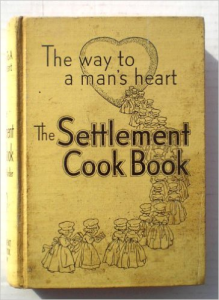By Sheila Orysiek

 SAN DIEGO — For many of us (of a certain age) the Settlement Cook Book was the first cook book we bought or received as a wedding gift. I bought my copy, 4th edition, published in 1910, with over 600 pages, within weeks of getting married and used it until it fell apart. Originally called “The Way to a Man’s Heart,” the first 1500 copies were printed in 1903, and included advertisements. It has since gone through thirty-four editions, has sold two million copies and still selling today.
SAN DIEGO — For many of us (of a certain age) the Settlement Cook Book was the first cook book we bought or received as a wedding gift. I bought my copy, 4th edition, published in 1910, with over 600 pages, within weeks of getting married and used it until it fell apart. Originally called “The Way to a Man’s Heart,” the first 1500 copies were printed in 1903, and included advertisements. It has since gone through thirty-four editions, has sold two million copies and still selling today.
The book contains many basic recipes of every day foods which most other cook books tend to ignore such as grilled cheese sandwiches and scrambled eggs. It then proceeds with more complex cookery and baking. A great range of ethnic cooking is covered which represents the diverse fabric of the immigrant population to the United States. Beyond cooking and baking are sections with suggestions and basic information of how to keep and run a household such as: how to dust, keep milk fresh, set a table, dietary information, choosing different cuts of meat, etc.
And, yes, it had its beginning in a Settlement House. With financial support from the Federation of Jewish Charities of Milwaukee, Mrs. Lizzie Black Kander opened a “Settlement House” to help immigrant women assimilate into American mainstream culture by offering training in vocational and domestic skills as well as classes in English, American history and music.
An except form the Wisconsin Historical Society:
“Born in Milwaukee in 1858, Lizzie Black Kander helped to establish and was president of Milwaukee’s first social settlement, known simply as “the Settlement” in 1900. With the financial support of the Federation Jewish Charities of Milwaukee, the Settlement offered training in vocational and domestic skills, as well as classes in English, American history, and music. Kander believed that food was a powerful means of religious and cultural expression, and she used culinary reform to aid in the assimilation of immigrant girls and to introduce immigrant women to American consumer culture. Her involvement in the cooking classes led to the publication of The Settlement’s own cookbook in 1901. In these excerpts, Kander defines the “Household Rules,” offers recipes for cakes and cookies, and discusses appropriate foods for invalids. Her sub-text throughout these culinary and domestic instructions is about helping recent immigrants adjust to mainstream American culture.”
My copy is the one pictured above.
*
Orysiek is a freelance writer who specializes in arts and literature. She may be contacted via sheila.orysiek@sdjewishworld.com. Any comments in the space below should include the writer’s full name and city and state of residence, or city and country for non-U.S. residents.
Sheila,
I grew up on this cookbook! And when I got married, was horribly upset that I did not receive a copy. I have my mom’s copy and I will not part with it. Written inside the back cover, are secret family recipes!
Thank you for a lovely reminder!
–Eva Trieger, Solana Beach, California